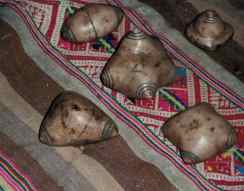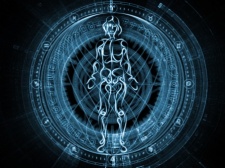Often, it’s not about becoming a new person, but becoming the person you were meant to be, and already are, but don’t know how to be.
—Heath L. Buckmaster, author
I am continually asked about the chunpis, especially by students of teachers other  than Juan Nuñez del Prado, who learned about them differently from the teachings of this lineage. Although I’ve written about them several times before, let me do so again as clarification and review. I’ll do so as an overview for those of you who want a quick “cheat sheet” about them.
than Juan Nuñez del Prado, who learned about them differently from the teachings of this lineage. Although I’ve written about them several times before, let me do so again as clarification and review. I’ll do so as an overview for those of you who want a quick “cheat sheet” about them.
Before I begin, however, I urge you to read again, and take to heart, the quotation that leads this post. If you want a concise statement of what the chunpis are all about, this quotation says it perfectly. The chunpis energetically encompass not only who you are right now, but who you have the potential to be—a fully realized human being.
- Chunpi literally means “belt” in Quechua. There are four primary chunpis, and they are commonly referred to as the belts of power. They are not belts of protection, as there is nothing to protect yourself against. In terms of the kawsay pacha—the cosmos of living energy—energy is just energy, beyond moral overlay. It can’t hurt you. Because of our emotions, thoughts, actions and so on, we can slow kawsay down, creating hucha, which detracts from our well-being. But hucha is not bad, negative, threatening, evil or anything of the kind. People can be negative, threatening, evil, but this is different from seeing kawsay, the living energy, as such. To deal with hucha, you do saminchakuy (or hucha mikhuy) to get that slow energy moving again at its natural speed.
- The chunpis do not exist in your energy body (poq’pq) until you “weave” them in the karpay called the Chunpi Away (pronounced chun-pee ah-why). They can fade over time if you don’t work with them regularly.
- The chunpis each contain a ñawi, a mystical eye, as do others parts of the body,
 such as the palms, soles of the feet, and top of the head. The ñawis are in place at your birth. However, they are “awakened” in a karpay called the Ñawi K’ichay (pronounced nyow-wee key-ch-eye), which is done at the same time you weave the chunpis.
such as the palms, soles of the feet, and top of the head. The ñawis are in place at your birth. However, they are “awakened” in a karpay called the Ñawi K’ichay (pronounced nyow-wee key-ch-eye), which is done at the same time you weave the chunpis.
- The chunpis are belts of power because they have energetic potential. They fuel certain capacities within you. The work of the chunpis is to grow in these capacities. Growing in these capacities increases your personal power to be in more perfect ayni with the kawsay pacha and to live with greater joy, success, and integrity in the human world.
- There are four main belts: the black belt (yana chunpi) around the hips and the lower trunk of the body. This belt confers the capacity of atiy, the power to take action in the world. It has to do with measuring your personal power at a specific point in time and with ascertaining right timing for taking action, among other things. The red belt at the belly/qosqo (puka chunpi) confers the capacity of khuyay, of acting with passion and focused engagement in the world. It is the place, therefore, of your kinetic power. The heart level chunpi is the qori chunpi, the gold belt. There is no hucha in this belt, so it never needs to be cleansed. It confers the power of the feelings (as opposed to the emotions, which are at the belly), and specifically of munay (love and will). Because it is the belt within which lives the Inka Seed, this belt also confers the capacity of kanay, to be who you really are and to live that in the human world. In fact, kanay is the main capacity of the qori chunpi. The throat belt, the qolqe chunpi, or silver belt, confers the capacity of rimay, of speaking with power and of creative expression of all kinds. You don’t weave the belts just to weave the belts! You work the energies there: the primary work of the chunpis is growing in these capacities and consciously evolving as a human being.
- These four belts are the primary ones. However, we sometimes say, for convenience sake, that there is a quasi violet belt that covers the head at the level of the three eyes—your two physical eyes and the seventh eye in the middle of your forehead (what other cultures call the “third eye.”) I won’t go
 into why we call it the violet belt, but you need to know that violet is not the actual color of the belt. The color of the belt is the color of your physical eyes. The capacity of the three eyes is qaway, visionary or mystical seeing and knowing.
into why we call it the violet belt, but you need to know that violet is not the actual color of the belt. The color of the belt is the color of your physical eyes. The capacity of the three eyes is qaway, visionary or mystical seeing and knowing.
- The karpays for weavng the belts and awakening the mystical eyes is usually done with mullu chunpis, a set of five stones, like those pictured. However, they are not necessary. You can do the karpays using only your intention (which is true of all the practices of the Andes, or else we are turning objects into fetishes).
The work with the chunpis is quite extensive, as the chunpis are the focus of some of the chaupi training and are heavily involved in the lloq’e work. But the main work of the belts is individual, based on your intention. Like all the work of this tradition, intention is what moves energy. It is your intention that helps you access and work the energies of the belts, and it is your intention that allows you to begin using the capacities each confers so that you can grow and transform.
All of the practices of the Andean tradition—including the chunpis—are directed toward this goal of becoming the most consciously evolved human being you can be so that you can live your divinity while here in physical form in the very human world. The capacities of the chunpis cover major aspects of being: speaking with integrity and power, cultivating compassion and love, knowing who you are and not being afraid to live your individual power, being able not only to form clear intentions but also to carry those intentions out through action, effortlessly and successfully.
If you are not working with the chunpis in these ways, then you are missing a core part of the teaching of the Andean path. Always remember, as a paqo you want to not waste your energy. You want to be super efficient and super effective in your ayni—your energetic engagement with the cosmos of living energy. Once they are woven, the chunpis are part of what I call the “energetic anatomy” of your poq’po. There is nothing in your physical body that doesn’t contribute to the core purpose of keeping you, as a physical organism, alive and healthy. The chunpis as part of your energetic anatomy serve fundamental and necessary purposes as well, integrating both your physical and energetic selves to so that you can excel at both the “action” of life and the “art of being” in life.
part of the teaching of the Andean path. Always remember, as a paqo you want to not waste your energy. You want to be super efficient and super effective in your ayni—your energetic engagement with the cosmos of living energy. Once they are woven, the chunpis are part of what I call the “energetic anatomy” of your poq’po. There is nothing in your physical body that doesn’t contribute to the core purpose of keeping you, as a physical organism, alive and healthy. The chunpis as part of your energetic anatomy serve fundamental and necessary purposes as well, integrating both your physical and energetic selves to so that you can excel at both the “action” of life and the “art of being” in life.

Love your blog about the Chunpis. Some of my students have been attracted to them, but have not been able to access any teachings. Adolfo says he will provide us some teachings but hasn’t had time yet! So thank you!!
LikeLike
Happy to hear you found this post useful. Adolfo has a different teaching from what I have heard. Not sure of the lineage it comes from or if it contains things from other traditions, like the chakras.
LikeLike
Very interesting read about the Chunpi belts. I have learned a very different teaching, with roots from Ausangate and find, as always, joy in the diversity of these teachings even within a small area.
LikeLike